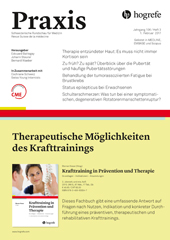Abstract
Zusammenfassung. Zur Beurteilung einer relevanten Pubertätsstörung ist es essenziell, die Physiologie der Pubertät zu kennen. Bei Mädchen ist die prämature Thelarche ein häufiger Konsultationsgrund. Meist benötigt diese keine weitere Therapie, muss aber gegen eine Pubertas praecox abgegrenzt werden. Diese braucht in jedem Fall weitere Diagnostik und möglicherweise auch eine pubertätshemmende Therapie. Bei Knaben ist hingegen die Pubertätsgynäkomastie und die Pubertas tarda ein häufigerer Vorstellungsgrund. Beides geht oft mit einem erheblichen Leidensdruck einher. Die physiologische Pubertätsgynäkomastie ist in den meisten Fällen nach 6–18 Monaten spontan rückläufig und bedarf nur selten einer weiteren Abklärung oder Therapie. Die Pubertas tarda tritt häufig im Rahmen einer konstitutionellen Entwicklungsverzögerung auf, differenzialdiagnostisch muss aber ein permanenter Hypogonadismus ausgeschlossen werden.
Abstract. Knowledge of pubertal physiology is of great importance to differentiate between normal and relevant pubertal disorders. Girls often seek attendance due to premature thelarche, which does not need any therapy in most cases. However, it must be distinguished from true precocious puberty that may need further evaluation and therapy. In contrast, boys often seek medical advice due to pubertal gynecomastia or delayed puberty. Both are conditions that lead to high psychological stress. Pubertal gynecomastia is quite common at the beginning of puberty and persists for about 6 to 18 months. Further evaluation and therapy is necessary only in selected cases. Delayed puberty often occurs due to constitutional delay, but has to be differentiated from permanent hypogonadism, which needs further evaluation and therapy.
Résumé. La connaissance de la physiologie pubertaire est essentielle pour en évaluer les principaux troubles. Chez la fille, une thélarche prématurée est un motif de consultation fréquent. En général, cette entité ne nécessite par de thérapie, mais il faut bien la distinguer d’une puberté précoce. Une puberté précoce nécessite par contre un bilan extensif et parfois un traitement. Chez le garçon, une gynécomastie pubertaire, une puberté tardive sont des motifs fréquents de consultation. Ces deux entités sont souvent accompagnées d’un stress psychologique. La gynécomastie pubertaire physiologique est le plus souvent spontanément régressive après 6 à 18 mois et ne nécessite en général pas d’intervention. Pour un retard constitutionnel de la puberté, il faut garder dans le diagnostic différentiel un hypogonadisme permanent.
Bibliografie
: Ausgewählte Themen der endokrinologischen Jugendsprechstunde. Monatsschr Kinderheilkd 2015; 163: 888.
: Sexuelle Reifung von Kindern und Jugendlichen in Deutschland. Bundesgesundheitsblatt Gesundheitsforschund Gesundheitsschutz 2007; 50: 677–685.
: Disorders of puberty: Take a good history!J Clin Endocrinol Metab 2016; 101: 2643–2646.
: Pubertal development in Swiss girls. Helv Paediatr Acta 1983; 38: 229–243.
: Vorzeitiger, verspäteter und ausbleibender Pubertätsbeginn. Monatsschr Kinderheilkd 2012; 160: 626–637.
, .: Associations between age at menarche and menopause with cardiovascular disease, diabetes, and osteoporosis in chinese women. J Clin Endocr Metab 2013; 98: 1612–1621.
, .: Early age at menarche associated with cardiovascular disease and mortality. J Clin Endocr Metab 2009; 94: 4953–4960.
: S1-Leitlinie: Gynäkomastie. AWMF-Register Nr 027/028. http://www.awmf.org. Letzter Zugriff: 1.1.2011.
: Gynecomastia and hormones. Endocrine 2016 May 4; Epub ahead of print.
: Leitlinie Männlicher Hypogonadismus. J Reproduktionsmed Endokrinol 2013; 10: 279–292.
: Pubertal induction in hypogonadism: Current approaches including use of gonadotrophins. Best Pract Res Clin Endocrinol Metab 2015; 29: 367–383.
, .: Expert consensus document: European consensus statement on congenital hypogonadotropic hypogonadism--pathogenesis, diagnosis and treatment. Nat Rev Endocrinol 2015; 11: 547–564.
: Testes. In: Greenspan’s: Basic & Clinical Endocrinology; 9th edition, McGrawHill Medical, 2011.



